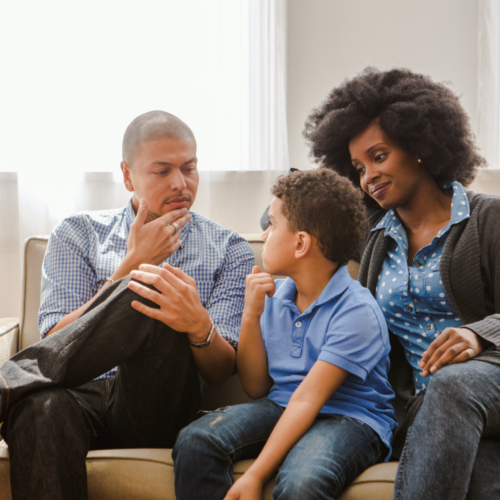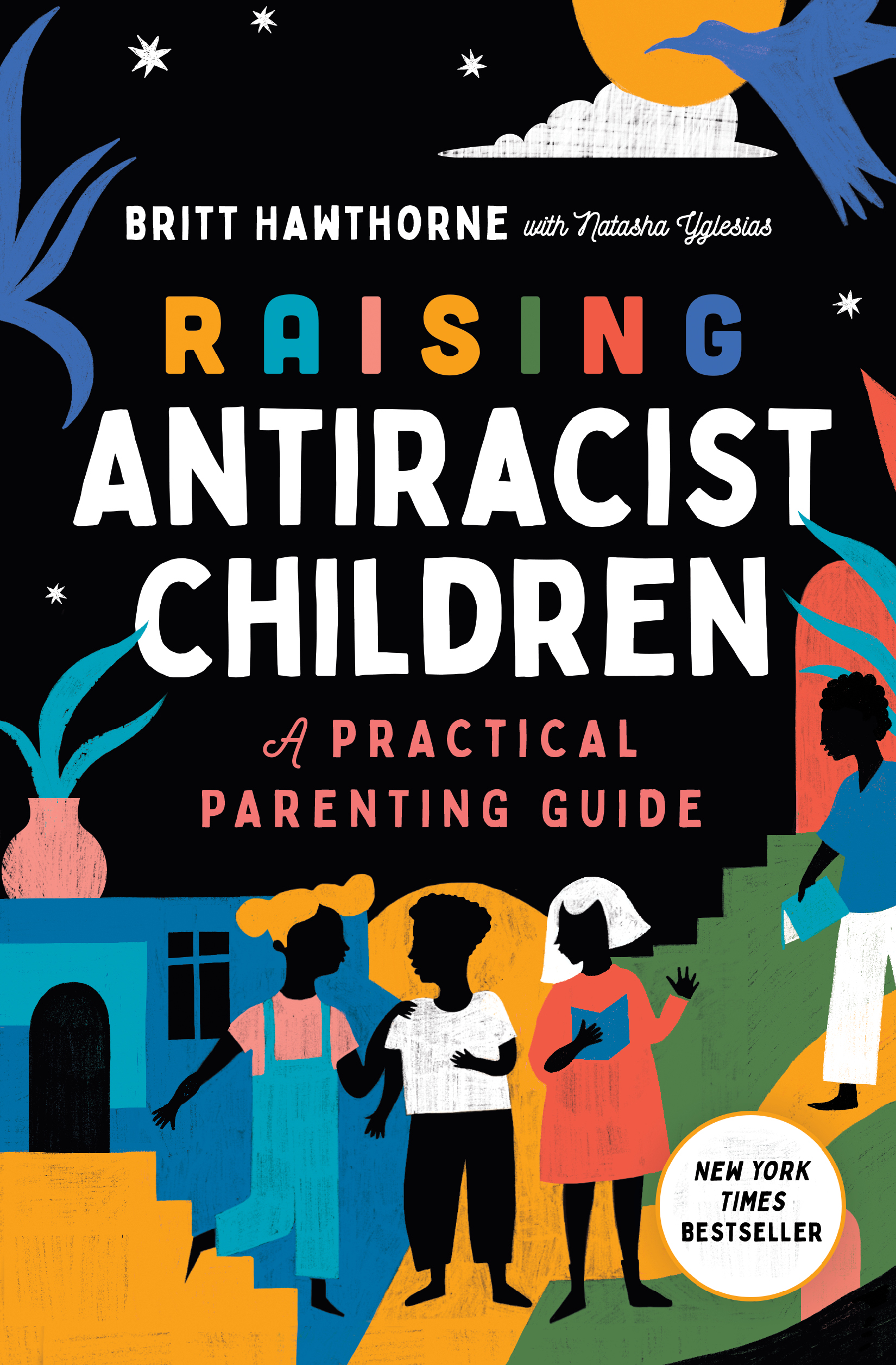What is body positivity—and how do you talk to your teens about it? Even as adults, many of us struggle with body-image issues. Due to a variety of factors ranging from racism to sexism to the diet industry, we are taught at a young age that being “fat” is wrong, and being “thin” is desirable. Instead of learning how to love and nourish our bodies, we are taught how to make them take up less space, and morph them into unattainable, arbitrary standards. Body positivity is a practice that fights against anti-fatness, helping us learn to love every body, and create a society of self-acceptance and self-love. Keep reading to learn about body positivity for teens.
What Body Positivity Means To Us
A few years ago, I started practicing body positivity. As you begin your own body-positive practice, and help your teens create one too, you will develop your own definitions of what body positivity means to you. To me, body positivity means accepting and appreciating my body, regardless of shape, size, or appearance. Practicing body positivity means emphasizing self-love and self-acceptance, and learning to foster a wholesome relationship with my body.
Being body positive has allowed me to accept the parts of my body that I cannot change and work to appreciate the parts I don’t love yet. It also means celebrating the parts of my body that I already love, too. I also focus on changing my mindset, offering myself permission to admit aloud, “I’m learning to love that part of myself.”
Body positivity shouldn’t be something we discover as grownups. Body positivity can be learned with the proper support and guidance. Let’s bring our children and teens on the journey of self-love and appreciation. Keep reading if you want to learn about body positivity for teens and develop a body-positive practice as a family.
Our Family’s Body-Positive Values
- Your questions and observations are valid and worthy of being discussed
- Puberty and sex aren’t taboo conversations in our home
- I’m a trusted adult that won’t judge or shame you
- What you’re experiencing is perfectly normal
- We’re on the journey of learning together
- You won’t have to figure it out alone
Body Positivity For Teens Begins With Loving Ourselves
Since middle school, I’ve felt insecure about my thighs. More than fifteen years later, wearing shorts in public is still a big deal for me. While my children probably aren’t concerned about their thighs, I know they’re concerned about something. And I don’t want this sentiment validated by the normalized body-negativity campaign that has a choke-hold on us.
“Body positivity for teens starts with the adults around them. It requires validating feelings of body negativity, then modeling how we’re learning to love pieces of ourselves.” – Britt Hawthorne
Body negativity focuses on changing or altering your body to meet unrealistic expectations. Perceiving oneself negatively regarding physical appearance can be incredibly detrimental to mental health. This harmful mindset can breed feelings of inadequacy, low self-esteem, and anxiety, leading individuals to romanticize the “perfect” body and beauty standards, further perpetuating self-doubt and shame. Not only can this impact one’s self-talk and body image, but it can also lead to harmful behaviors. Body negativity is learned and can be unlearned with the proper support and guidance.
Children and Young Adults Eating Disorder Statistics
According to the National Association Of Anorexia Nervosa And Associated Disorders:
- 42% of 1st-3rd grade girls want to be thinner.
- 81% of 10-year-old children are afraid of being fat.
- 46% of 9-11 year-olds are “sometimes” or “very often” on diets.
- 35-57% of adolescent girls engage in crash dieting, fasting, self-induced vomiting, diet pills, or laxatives.
- Larger body size is both a risk factor for developing an eating disorder and a common outcome for people who struggle with bulimia and binge eating disorder.
- BIPOC with eating disorders are half as likely to be diagnosed or to receive treatment.
- LGBTQ youth with body dissatisfaction had twice the odds of reporting a suicide attempt in the past year compared to LGBTQ youth with body satisfaction.
- In a college campus survey, 91% of the women admitted to controlling their weight through dieting.
The Problem With “Ugly”
Anti-fatness or fatphobia creates a narrative around what constitutes beauty and ugliness. The message to your children and teens is that “beautiful” people are worthy of love, safety, and respect, while “ugly” people are not. Ugliness is often associated with poor character, laziness, or lack of popularity.
Teenagers who think they’re “ugly,” think they’re not good enough to be loved or worthy of things like respect, value, and dignity. But another problem is that they also think that ugly people, in general, are not worthy of these things either.
Body positivity is about unlearning how someone’s body looks has anything to do with their worthiness or personal qualities.
Body Positivity for Teens: 14 Things To Know
Disclaimer: I am not a health teacher, sex-education expert, doctor, or mental health clinician. My information is intended for general informational purposes only and should not be considered professional advice. For specific and personalized guidance, it is always recommended that you consult with qualified healthcare professionals or experts in the respective fields. Please know that I do not assume any responsibility for your actions based on the information provided.
Feedback: We welcome your feedback on this article and additional ideas and reflections. Please send your feedback and comments to contactme@britthawthorne.com
So much of being body-positive revolves around ensuring that you and others treat your body respectfully. Your child can make informed decisions and prioritize their health and well-being by being informed, vigilant, and empowered. Just like anything, approach body positivity with curiosity rather than fear. If you want to start immediately, keep reading to learn about body positivity for teens.
1. Every Body Is Unique
Every single body is different by design. No matter what mainstream media tells us, there is no such thing as the right kind of body. Your body is built based on its genetics and your family’s lifestyle.
2. Always Care For Your Mental Health
Mental health involves social, emotional, and psychological well-being. Taking care of our mental health is just as important as our physical health—and the two are interconnected. Moving your body, eating nourishing foods, sleeping, playing, and being creative all help you to have good mental health. In turn, you’ll feel more balanced, confident, and able to handle the challenges that will come with life.
3. Exercising Is About Joy and Fulfillment
I know Joe Blow on TikTok is telling you to hit the gym to focus on losing weight and lifting more, but that’s not the point. The point of exercising is to reduce pain and the risk of injury and to have fun moving your body. And there’s more than one way to accomplish this task. Whether martial arts, rowing, rock climbing, strength training, cycling, or gymnastics, find some activities that make moving your body enjoyable. And remember, bodies are different. You’ll have to find what works best for your body. Therefore, don’t limit yourself to one particular movement.
4. All Food Is Good Food
You’ll learn about dozens of different diets, meal plans, fads, and trends throughout your lifetime. You can always spot them because they’re one-size-fits-all plans that focus on restrictive and unsustainable eating patterns that promise short-term results. They’ll use words like “clean,” “good,” “bad,” “cheat,” “detox,” and sometimes “healthy” in a way that provokes strong emotions. You know your body best. Focus on the foods that help you stay active, and eat various foods daily, including protein, fat, fruits, vegetables, and grains.
5. Lift Weights
You can confidently engage in strength training (not to be confused with weightlifting, bodybuilding, or powerlifting) to develop stronger bones and muscles, improve overall fitness, enhance sports performance, and promote healthy body composition. Remember, beginning with a thorough warm-up is essential, and proper form and technique should be maintained while using appropriate equipment and weights. Gradual progression is vital.
Remember, the goal is not to lose weight but to build a healthy mind and body. Learn more about how we can fight anti-fatness together in my previous blog post.
6. Consent
Consent is an agreement to participate in any activity. You have the right to say no to anything that makes you feel uncomfortable or unsafe. And anyone has the right to tell you no to anything that makes them feel uncomfortable or unsafe. This includes unsafe driving, underage drinking, substance use, touching, kissing, physical advances, and relationship status.
Learn more about consent with my blog post featuring books about consent for every age.
7. Sexual Consent
Sexual consent involves a conversation between everyone involved. Embrace open communication, prioritize enthusiastic agreement, and when applicable, say no confidently. Enthusiastic consent is the standard in every situation and every relationship. Remember, people are in charge of their bodies. Without consent, any sexual activity—from touching to penetration—is considered rape or sexual assault. To keep it manageable, use the FRIES acronym.

8. Puberty
Puberty is a natural stage of life that every person experiences. People with a uterus usually undergo puberty between 9 and 14, while people with penises experience puberty between 10 and 16. This period involves several changes, such as breast growth, hair growth under the arms, and voice changes that may deepen. Additionally, some may experience increased muscle mass and facial hair growth, while emotional changes like mood swings and attraction to others can occur in all genders. It’s important to remember that puberty can begin and progress differently for each person, and what you’re experiencing is a normal part of growing up.
9. Hygiene
Fun fact, a person’s hygiene routine will depend on their cultural background, upbringing, and resources. There isn’t one right way to have a “good” hygiene practice, so focus on a balanced approach that’ll improve your overall well-being. In our family, we expect constant hand washing, daily bathing, skincare, and teeth care, and nail care when needed. The focus is on protection and prevention. Your peers are also learning what is hygienic and developing their practice, so it’s essential to be non-judgmental when discussing hygiene with your friends.
10. Harassment
Everyone has the right to feel safe and protected in all aspects of their life. Harassment can occur when someone intentionally bothers or threatens another person, causing them pain or fear. Examples of harassment include hurtful comments, insults, physical actions, name-calling, spreading rumors, threats, unwanted physical contact, or sending hurtful online messages. You might experience harassment at school, work, in public, online, or by a loved one. No matter where, when, or by whom, it’s never your fault, and you don’t have to endure. Set a boundary and remove yourself from the situation.
11. Sexually Transmitted Infections
Regular testing helps detect infections early and allows for timely treatment or management. Sexually transmitted infections (STIs) can be classified into two main types: bacterial and viral. Bacterial infections such as gonorrhea, chlamydia, and syphilis can be cured with antibiotics, and proper treatment helps eliminate the bacteria from your body. However, viral infections such as HIV, HPV (human papillomavirus), and herpes cannot be entirely eliminated from the body, although their symptoms and transmission can be managed using various methods, including antiviral medications and vaccines. It is essential to get tested for STIs at least once a year or whenever you have a change in sexual partners.
12. Piercing and Tattoos
Body modification encompasses a range of intentional alterations made to the body for self-expression, cultural significance, or aesthetic preferences. For tattooing and piercing, look for a reputable licensed artist that prioritizes hygiene and safety measures. Ensure the artist uses a fresh pair of disposable gloves, needles from sealed containers, and new pigment trays. These precautions indicate that the artist takes sanitization and sterilization seriously. If you notice that the tattoo parlor or artist doesn’t follow these practices, it’s a clear sign that they are not respecting your body or your concerns. In such cases, it’s best to leave immediately.
13. Virginity is a Social Construct
You might be surprised to know that virginity is a social construct, which means that it is an idea that has been created and accepted by people in society, but it does not have any objective truth. Society has created the term “virginity” to describe someone who has not engaged in sexual intercourse. However, it’s essential to understand that it means different things to different people and cultures. The idea of virginity can vary based on personal beliefs, cultural norms, and individual perspectives. Here’s the important part: your worth has nothing to do with whether you’ve done the deed. What matters is that you’re making informed choices, practicing safer sex, and always putting your boundaries and consent first.
14. Menstrual Cycles
Some of your peers will have a menstrual cycle. The menstrual cycle is a recurring process in the reproductive system of individuals with female anatomy, typically lasting around 28 days, involving the shedding of the uterine lining (menstruation) and the release of an egg (ovulation) in preparation for a potential pregnancy. There is nothing shameful or embarrassing about it, but many stereotypes portray PMS (premenstrual syndrome) and “that time of the month” as negative rather than honest. Your job is to avoid jokes, name-calling, spreading misinformation and stereotypes. You live in a society and are in relationships with people who menstruate, so you are responsible for being empathic, aware, and supportive. Continue to educate yourself about the physical and emotional toll menstruating can take on people and know how to offer support.
Working Together As A Family
It’s important to talk about body positivity with your teen. Incorporate these discussions into your routine and encourage self-acceptance and appreciation of diversity. Remember to be empathetic and offer positive reinforcement. Together, you can help your teen build a wholesome relationship with their body. While these 14 body-positive things are not an exhaustive list, I hope it’s a helpful one. If you’re looking for more resources, I provide activities for discussing media, food culture, beauty trends, the pink tax, and much more in Raising Antiracist Children: A Practical Parenting Guide.
If you enjoyed this article, consider buying me a cup of coffee. I’m Britt, a Black bi-racial momma, author, and anti-bias facilitator, who provides free resources to families on subjects ranging from ableism to antiracism.





